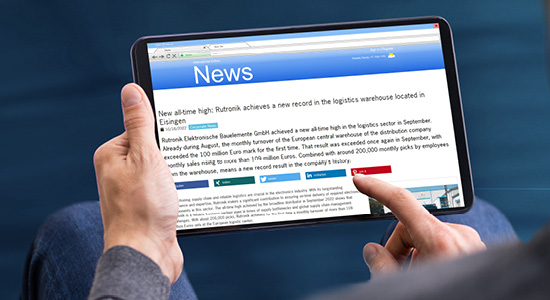What makes Rutronik System Solutions something completely new for Rutronik?
Stephan Menze: We are at home in classic component sales. This means that everything – from the actual product, sales, and support to logistics processes – is carried out at product level. With Rutronik System Solutions, we can now operate at system and/or solution level; in other words, far beyond the products. In some cases, this has fundamental implications.
Can you give us an example?
Menze: It starts with the fact that we develop boards and highly innovative solutions ourselves. This means unconventional development and research work, not only for Rutronik but for the entire distribution sector. When the systems are ready for sale, the process is usually the other way around: It often does not begin with a customer inquiry; instead, we typically initiate contact with the customer and present our solutions. That is the reason why we have not only done an incredible amount of development work over the past two years, but also set up new structures and processes. When I joined Rutronik back in 2015, it was still a completely different world. For our sales colleagues, this all means new tasks associated with complex systems that require a great deal of explanation. Internal communication and training sessions are therefore extremely important. We are currently in the process of gradually equipping all our sales offices with cases containing our entire board portfolio and training the sales teams accordingly. This process commenced in the DACH region, with a gradual expansion to other European countries, Asia, and the USA to follow. We have also developed an internal smartphone app that enables us to demonstrate our solutions in action to customers on site, for example using live measurements.
What has been the feedback from customers so far?
Menze: From most customers – but also from suppliers to whom we present our developments – you hear things like: “Nobody else does it this intensively.” Developing something based on supplier boards is not unusual in the world of distribution, but creating your very own solutions definitely is. The positive feedback shows that we have chosen the right path. Infineon is so convinced of our boards that they have integrated them into their development software. This means that customers can select the Rutronik boards and our sample software directly in the Infineon development software. Normally, it is the other way around, with the Infineon products being available from Rutronik. So, in this case, the supplier has clearly recognized the added value of our solutions.
And what is that added value?
Menze: First and foremost, a significantly shorter time to market and a much lower investment in pre-development on the part of the customer. After all, Rutronik has already done most of the development work. How far this goes depends on whether the solution is at design level, advanced design level, or research level. Especially at the upper levels, our goal is to create solutions that help solve real pain points for our customers.
Andreas Mangler: The special thing about this is that we always think from the end customer's perspective, i.e. from the point of view of our customers' customers. By taking this next step in the value chain, our customers – OEMs and branded companies – also appreciate great added value for themselves. Our research-level developments are next-level, high-tech products that amaze even our contacts at large companies.
Can you give us some examples of these solutions?
Menze: There is HESS, for example, our hybrid energy storage system, or the electronic nose, which uses AI to detect specific substances. For example, we can use it to distinguish between different types of coffee.
What stage are these projects currently at?
Mangler: We have already patented them, and prototypes of both are now available and already being evaluated by very large, well-known pilot customers. After years of development work, this is a huge milestone. Even if not every pilot customer actually implements a project straight away, I am sure we will be talking about some specific details in a year or two.
What happens if a customer wants to implement the project?
Menze: To use Rutronik’s patents, they must contractually commit to purchasing the board’s key components exclusively from Rutronik for a certain period of time. This gives the customer access to our core know-how and the freedom to use our patented technology; we also support them when it comes to implementing their specific application. This support goes far beyond the products, and customers also benefit from the experience that our team has already gained during development.
Is that the end of the research work for now?
Mangler: No, we are simultaneously pushing ahead with several projects. In the case of the wasp scare, for example, the laboratory tests at our partner universities did not deliver the desired results, prompting us to return the project to internal research and pre-development. Our goal is to bring all Level 4 projects to the point where we can offer our customers real added value. That is not always the case in the research field in which we work here.
What does that mean, “return the project to internal research”?
Mangler: We have been working very closely with universities and research institutions for a number of years now. As a result, we have good connections to top experts in various fields, with whom we exchange ideas at the highest level. Our task is, on the one hand, to pass on the industry’s requirements profile to research to ensure the solutions created give companies a real competitive edge on the market. On the other hand, we translate research know-how into what is technically feasible. In other words, we bridge the gap between research and industry. And although the result is next-level, high-tech solutions, they are not boards full of “golden screws”. Instead, we deliberately use immediately available components from our franchise partners.
What is happening at the other levels of Rutronik System Solutions?
Menze: At Level 3, we have our base boards. We released RDK2 in 2022, and RDK3 and RDK4 in 2023. Meaning we have also taken a big step forward here, too, and completed our portfolio for the time being. At the moment, we are concentrating on Level 2, which means we are combining suppliers' boards with our own and thus constructing specific sample applications.
What kind of applications?
Menze: One example is distance measurement. To do so, we connect a radar module from Infineon or Nisshinbo, a time-of-flight sensor from ams Osram or – for the simplest kind of presence detection – an infrared sensor from Vishay to our base boards. This allows the customer to immediately test several solutions that differ in terms of precision and price – and without any hassle with the development environment. If the supplier board has an Arduino interface, which we also use for the RDKs, it can simply be plugged onto the RDK2, 3, or 4. The customer also receives the development software from Rutronik. So we are gradually creating more and more specific use cases based on our boards, for which we also develop the corresponding user guides, app notes, and so on.
So the RDKs are technically interchangeable. What makes them different?
Menze: Exactly – we have intentionally designed the base boards without specific use cases in mind, thus ensuring their versatility and broad application. The difference is mainly found in the microcontroller and the interfaces. As a result, each board is geared to a specific market: The RDK2 is for industrial IoT or industrial robotics. The RDK3 has a microcontroller with security features and Bluetooth low-energy function. Further, it is much smaller and more compact than the RDK2. This makes it ideal for IoT wireless devices, for example for smart buildings, but also for healthcare scenarios, where security plays a role. The RDK4 is aimed at the automotive market, as it has an automotive-qualified microcontroller and corresponding interfaces. It also has the exact features that developers need to design small motor control units for vehicles.
Rutronik effectively relieves its customers of the burden of development and, in some cases, research work, off its customers shoulders. That requires an immense upfront investment.
Mangler: That is true. But we are convinced that we have chosen the right path. Since the market is demanding more and more system solutions and Rutronik will be able to offer more of these in the future. This clearly sets us apart in the distribution landscape. We have already talked about the fact that this has been very positively received by customers and suppliers. In the meantime, we now also have a fixed research budget. The Rutronik Executive Management is, therefore, fully behind these activities. We take great pride in our unprecedented achievements within the traditional component distribution sector.
Menze: This also applies to the entire Rutronik Systems Solutions segment. Two years ago, we started out with two people, and now there are six of us. This not only gives us more time resources, but also a strong team with outstanding expertise in various disciplines. This takes our work to a new level. We can drive developments forward much faster and the learning curve just gets steeper. The dynamics behind this are really fun!
Rutronik System Solutions comprises four levels, ranging from the foundation at product level to the top with self-developed, patented systems.
Developing something based on supplier boards is not unusual in the world of distribution, but creating your very own solutions definitely is. The positive feedback shows that we have chosen the right path.
In other words, we bridge the gap between research and industry. And although the result is next-level, high-tech solutions are created in the process, they are not boards full of “golden screws”. Instead, we deliberately use immediately available components from our franchise partners.
For more information and a direct ordering option, please visit our e-commerce platform at www.rutronik24.com.
Subscribe to our newsletter and stay updated.


